Places Visited: Nebraska; Gering, Scotts Bluff, Chimney Rock, Scotts
Bluff National Monument, Robidoux Pass, Wildcat Hills State park
July
5 & 6 2006: Gering & Scotts Bluff, Nebraska. We are in Robidoux RV-Park
operated by the city of Gering N41° 48.757' W103° 40.644' phone: 308-436-2046.
They have paved interior roads with concrete pull-thru pads featuring green grass
overlooking Scotts Bluff the bluffs so often mentioned by travelers on the Overland
Trail: 50-amps, water and sewer, $15.
We headed north out of Greeley on
the 5th of July heading to Scotts Bluff, Nebraska where we plan to meet up with
the old Overland Trail (Oregon Trail, Mormon Trail, California Trail). While the
Overland Trail started in Independence, Missouri we are going to start following
it west from Scotts Bluff, Nebraska.
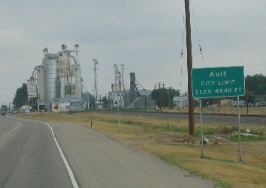
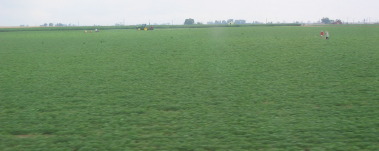
As we head north out of Greeley we are overwhelmed by the sight of so much agriculture.
Fields of onions, beans, alfalfa and corn fill open spaces while silos and grain
elevators make up the small towns.

Irrigation
makes this all possible, including this dairy operation just east of Ault.
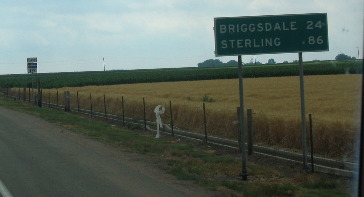

Eastern
Colorado is in the rain-shadow of the Rocky Mountains and traditionally only gets
around 12 to 15 inches of rain each year. Land that is not irrigated is still
short grass prairie. In the small town of Ault on US-85 10-miles north of Greeley
we turn east for around 50-miles on SR-14 where we quickly run out of irrigated
land. Not long after the irrigated land disappears we enter Pawnee National Grasslands
where the traditional short-grass prairie is being maintained as it was in the
1800's. Land not part of the Pawnee National Grasslands system is being used as
open range land or cultivated for grain. Throughout our journey today we see huge
fields of grain probably some type of wheat.

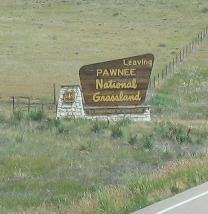
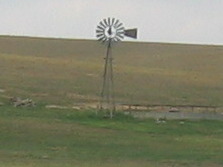
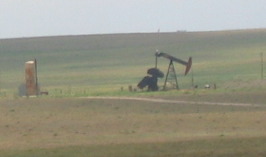
Wind
mills and solitairy oil wells were spotted from time to time as we made our way
across the open expanses of this prairie. Private lands were being used to grow
grain or graze cattle.

In
Stoneham we turn north on SR-71 that took us into Gering. Nebraska. On SR-71 we
stayed in the Pawnee National Grasslands for the next 50 miles.
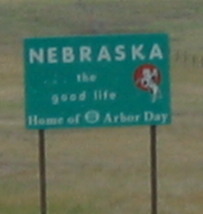
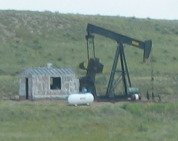
At
the Colorado Nebraska border we finally emerge from Pawnee National Grasslands.
The occasional oil well is easily spotted.
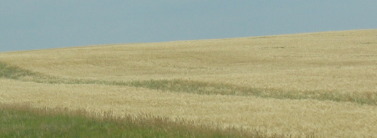
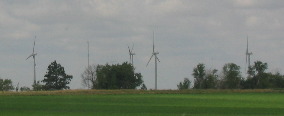
Just north of the Colorado Nebraska border we cross I-80 and enter the small town
of Kimball, Nebraska a town on the cusp of energy independence. North West of
town we spot a group of large wind generators perched on a hill overlooking town.
Later we read where that wind farm generated power for 4,000 residences.

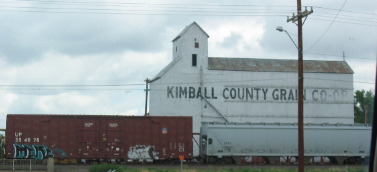
Around
Kimball we also started seeing evidence of irrigation. This field of irrigated
alfalfa hay is just one example of irrigation around Kimball.

Not
far out of Kimball the area turned to dry farming with grain fields filling the
landscape.


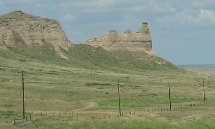
Nearing
Gering we started seeing the bluffs this area is known for.


While
the bluffs supply an interesting backdrop fields of alfalfa and corn fill the
valley floor.

Let
it be said that irrigation will turn the desert green. That is Scotts Bluff in
the background of the picture on the left.
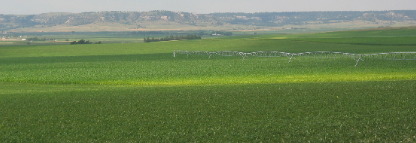
The
Gering, Scotts Bluff valley area along the North Platt River turns out to be extremely
scenic, bucolic if you will. What was a bone dry short grass prairie just a few
miles south is now a vibrant bright green farming valley with corn, sugar beets,
several varieties of dried beans and alfalfa hay are occupying what appears to
be the entire landscape of the broad valley.
Joyce had a full day planned
and we only had a half day to pack it in. As soon as we set up we headed out to
the North Platte Valley Museum in Gering. This was a wonderful museum that got
us up to speed on the history of the area especially the Overland Trail that flowed
through here from the mid-to-late 1800's. In fact one of the popular routes went
right by the museum.
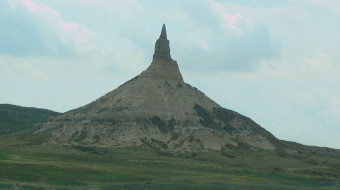
After
the museum we traveled east to Chimney Rock a spire of solitary grandeur, visible
for miles to pioneer travelers approaching from the flat prairie to the east.
Of all the curious rock formations along the trail, none drew more comment from
passing pioneers than Chimney Rock.
In the early days
Chimney Rock was a guide for "mountain men" the rocky Mountain trappers
and traders on their seasonal travels between the Rockies and Missouri River trading
posts. The first white men to see Chimney Rock may have been Robert Stuart and
a small group of traders on their way back from Astoria on the Oregon Coast in
1813. It would be 14-years later, in 1827, before the first recorded use of the
name occurred in Joshua Pilcher's report on his journey up the Platte Valley to
the Salt Lake rendezvous of the fur trappers. After these early mentions of Chimney
Rock thousands of pioneers followed each with their own recollection of the strange
rock spire.
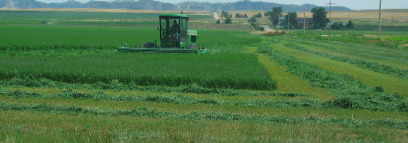
The
ride along the North Platte River to and from Chimney Rock we were filled with
awe at the beautiful crops that seemingly stretched forever.

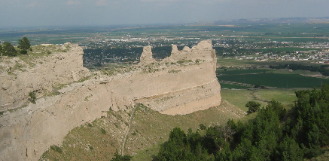
Back in Gering we headed to Scotts Bluff National Monument where we were
able to drive to the top of the bluff and overlook the towns of Scotts Bluff and
Gering.
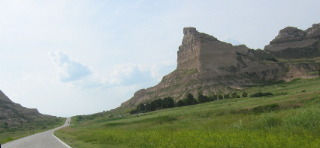
While
there we also walked part of the Overland Trail that went through Mitchell Pass.
That is Mitchell Pass in the picture to the left. The trail we walked is
only a short distance to the right of the highway.
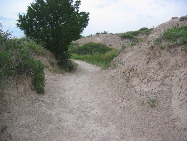 Pioneers
used a variety of routes to negotiate Scotts Bluff. Over the years different routes
were used. Mitchell Pass was the shortest route thus the preferred even though
it was a tough climb and very narrow. We walked the narrow part where all wagons
were forced to form a single line. The gouge in the soft sandstone in the pass
was around 6-feet deep even though the wagon ruts were not visible. Time and erosion
of the soft sandstone over the past 130-plus years has erased the ruts and all
that remains is the deep gouge across Mitchell pass.
Pioneers
used a variety of routes to negotiate Scotts Bluff. Over the years different routes
were used. Mitchell Pass was the shortest route thus the preferred even though
it was a tough climb and very narrow. We walked the narrow part where all wagons
were forced to form a single line. The gouge in the soft sandstone in the pass
was around 6-feet deep even though the wagon ruts were not visible. Time and erosion
of the soft sandstone over the past 130-plus years has erased the ruts and all
that remains is the deep gouge across Mitchell pass.
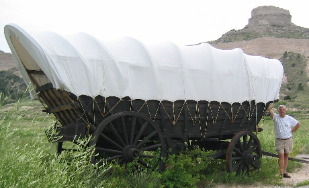
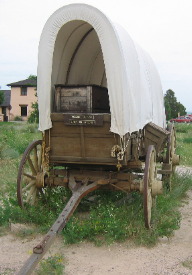
To
the left is a freight wagon that would hold up to 5,000 pounds and was pulled
by a team of up to 10 oxen.
To the right is a normal pioneer wagon that
would hold up to 1,500 pounds and be pulled by two oxen.
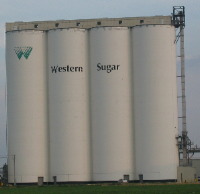

Western
Sugar in Scotts Bluff was the refinery processing sugar beets in the region. We
saw fields of sugar beets, and farmers working the fields but none were harvesting
the beets. We might get to see that another time.

We
could see the sun setting over Mitchell Pass from our RV. Joyce was outside to
record the event.
During the night we decided
that we had not seen everything we wanted to see in the area and we needed to
stay in the area for another day.
The next day we took Joyce's list of things
to see and do and headed out.
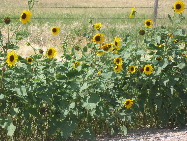

Driving
out Robidoux Road to Robidoux Pass was first on the list. Robidoux conducted a
trading business with Indian tribes in the 1820's.
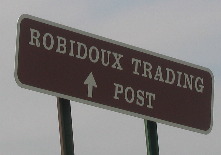
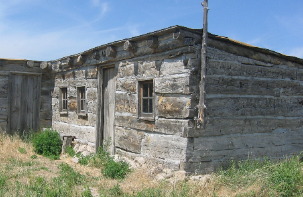
He
and his Indian wife built a trading post where he traded first with local Indians
then with pioneers as they made their way west. Robidoux operated a foundry where
he repaired wagon parts among other endeavors.
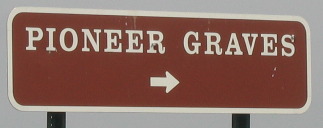
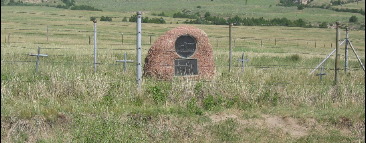
Viewing
Robidoux Pass was as eventful as experiencing Mitchell Pass. Traveling in a car
where pioneers walked with their wagons was a humbling experience. Viewing their
grave sites was also humbling.
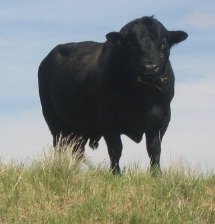
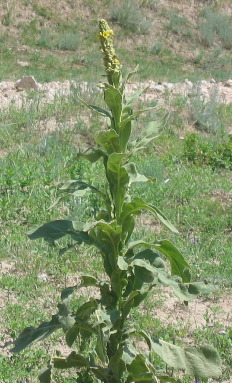
It
was a 15-mile drive out a dirt road to get to Robidoux Trading Post an the far
end of that drive was getting into desolate country where this bull gave us the
evil eye like we might be intruding on his herum of cows. Incidentally, this far
out is open-range country meaning no fences. We were eyeball to eyeball with that
bull.
To the right is that "Charmin-weed" do you remember the
weed that had leaves soft enough to be used as toilet paper?
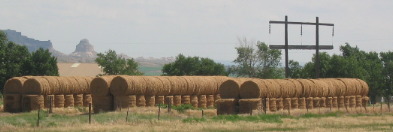
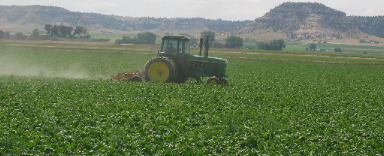
Closer
to civilization and paved roads we were able to see these modern agricultural
sights. The tractor on the right is tending to sugar beets.
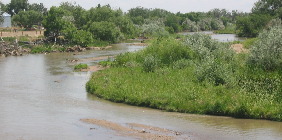
The
North Platte River is what makes all this agriculture possible.
On the way back from Robidoux Pass Joyce navigated us to a wildlife viewing area
where over 40-big horned sheep live in the bluffs. We looked but did not see them.
Wildcat Hills State Park and big game reserve was next on our list. Views from
the bluff in the state park were spectacular but we did not see any of the elk
or buffalo in the park. We did see one big mule deer that scampered off when we
approached.
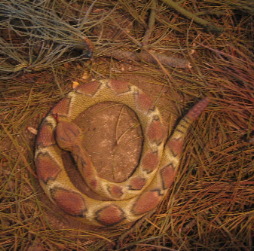
This
lone rattle snake was the only picture to come from Wildcat Hills State Park.
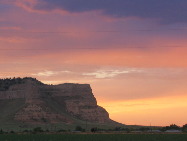
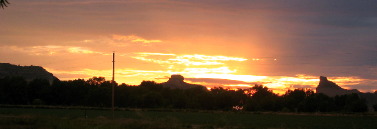
Our
last night in Robidoux RV-Park in Gering offered this magnificent sunset over
Scotts Bluff on the Overland Trail.
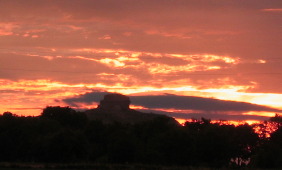
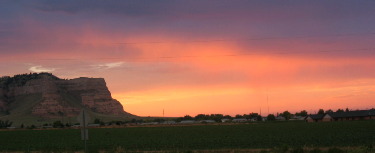
The
sunset mixed in with the strange forms of those bluffs really made for an exciting
event.
The two days we spent in
Gering and Scotts Bluff couldn't have been any better.
Until next time remember
how good life is.
Mike & Joyce Hendrix